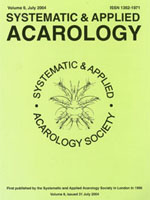Jatropha curcas L., once considered as a border or fence plant in India, has recently attained a new economic dimension as a biofuel crop. Though this crop suffers less damage from pests and diseases, some do cause a certain amount of injury. Phytophagous mites, namely broad mite, Polyphagotarsonemus latus (Banks), and red spider mite, Tetranychus urticae Koch, infest Jatropha curcas. Experiments were conducted during the year 2005–2006 to study the population dynamics and biology of these mites. The populations of broad mite and of the red spider mite were highest during November and October, respectively. The total life cycle of broad mites lasted six days; females and males lived for nine and seven days, respectively, whereas that of the spider mite was six days. Among several chemicals assayed, abamectin 0.0009% provided best control of both pests.
How to translate text using browser tools
1 September 2007
Bioecology and management of spider mites and broad mites occurring on Jatropha curcas L. in Tamil Nadu, India
J. Kavitha,
K. Ramaraju,
V. Baskaran,
P. Pretheep Kumar
ACCESS THE FULL ARTICLE
BIOLOGY
Broad mite
Efficacy
Jatropha curcas
population dynamics
red spider mite





